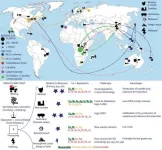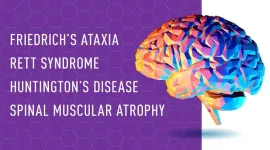(Press-News.org) ITHACA, N.Y. – Shallow lakes and ponds emit significant amounts of greenhouse gases into the atmosphere, but emissions from these systems vary considerably and are not well understood.
Now, a new Cornell University-led study measures methane and carbon dioxide emissions from 30 small lakes and ponds (one acre or less) in temperate areas of Europe and North America, revealing that the smallest and shallowest bodies of water exhibit the greatest variability over time.
The paper marks an important step toward calibrating climate models so they better predict emissions from inland waterbodies, and it points to the need to study small waterbodies more closely.
“This study helps understand both the drivers of greenhouse gas concentrations, and importantly, what makes some ponds more variable in their concentrations,” said Meredith Holgerson, assistant professor of ecology and evolutionary biology and senior author of the study, published in the journal Limnology and Oceanography.
“The paper points to patterns across a broad geographic range, such that we can actually get in and predict which waterbodies are going to vary and will be most variable, and it confirms that we need to go out and sample frequently,” said Nicholas Ray, a postdoctoral researcher in Holgerson’s lab and the paper’s first author.
Holgerson and colleagues have previously estimated that shallow lakes and ponds may contribute 5% of the global methane emissions to the atmosphere. But without accurate measurements across many water bodies, they said, the true number could be as little as half or as much as twice that percentage.
While some small lakes and ponds emit greenhouse gasses in consistent, predictable amounts, others are highly variable. Understanding these dynamics is important as carbon dioxide and methane act as greenhouse gases in the atmosphere, with methane being 25 times more potent at trapping heat than carbon dioxide.
Each body of water analyzed was sampled over the 2018 and 2019 summers at three times in three locations, including the deepest point and then two locations on opposite ends (but not too close to the shore).
“One key result we found was that the smaller the system is, in regard to surface area, the higher emissions are likely to be,” Ray said.
For carbon dioxide, samples were consistent in all parts of the waterbody, which revealed that researchers likely only needed to collect a sample from one location to get an accurate prediction of the whole body of water. Methane, on the other hand, required samples from multiple locations to get an accurate measure. Also, for methane, shallower systems were more variable, suggesting stratification of the water column in deeper water may prevent gases from rising to the surface.
For carbon dioxide, the amount of plant life in the water played a large role in variability over time. For methane, variability was more driven by the water depth and likely associated with stratification in the water column.
Among other uses, the study sets the groundwork for informing a New York state climate mitigation strategy to build more ponds to help farmers better handle droughts.
“We’re working to identify how ponds can be built, or if there are simple management strategies people can employ, to minimize emissions,” Ray said.
For additional information, see this Cornell Chronicle story.
Cornell University has dedicated television and audio studios available for media interviews.
-30-
END
Measuring greenhouse gas from ponds improves climate predictions
2023-06-06
ELSE PRESS RELEASES FROM THIS DATE:
Cobalt mineralogy at the Iron Creek deposit, Idaho cobalt belt, USA: Implications for domestic critical mineral production
2023-06-06
Contributed by Laura Fattaruso, GSA Science Communication Fellow
Boulder, Colo., USA: A new study published in Geology evaluates the potential for cobalt extraction from the Idaho Cobalt Belt (ICB) of east-central Idaho, using a detailed study of the Iron Creek deposit. The ICB hosts the second largest known domestic resource of the critical mineral cobalt, one of the key ingredients in many rechargeable batteries needed for the green energy transition. Demand for cobalt is projected to increase more than 500% by 2050. Roughly 70% of the cobalt mined globally is from the Democratic Republic of the Congo, where mining practices have been criticized for human rights violations including ...
Predictive models show wildlife managers where to find destructive feral swine
2023-06-06
UNIVERSITY PARK, Pa. — Feral swine are considered one of the top invasive species of concern in North America because of the damage they do to agricultural and natural systems. To best manage them, resource management agencies need to know more precisely where and when to implement control methods. A new study by a Penn State-led research team developed a method to help guide control efforts in the Great Smoky Mountains National Park.
Descended from wild European boars imported centuries ago that bred with escaped domestic pigs, feral swine cause widespread damage to ecosystems by wallowing ...
Revolutionizing optical control with topological edge states
2023-06-06
Nanophotonics and topology have gained significant interest due to the unique properties they offer. One area of focus is the investigation of topological edge states (TESs). These states have captured widespread attention because they are very resistant to errors and imperfections. Arising from topologically nontrivial phases, TESs provide a powerful toolkit for the architectural design of photonic integrated circuits. TES transport has led to the discovery of various intriguing optical effects and applications, including directional couplers, one-way waveguides, mode-locked waveguides, ...
Research to develop new rare disease therapies underway at The Jackson Laboratory
2023-06-06
Researchers led by Cathleen Lutz, Ph.D., are using an exciting new method, preclinical genomic editing, to develop safe, effective therapies for rare diseases and bring them to the clinic.
Unfortunately, the translation of the accumulated knowledge to safe and effective therapies has lagged. There are many reasons to predict that the situation is changing for the better, however, as powerful new gene-based therapies succeed in clinical trials and receive FDA approval.
Therapeutic strategies such as gene replacement and gene modulation (e.g., blocking protein production with anti-sense oligonucleotides) are at the forefront of the recent progress. ...
Elizabeth Anderson and Alondra Nelson win 2023 Sage-CASBS Award
2023-06-06
Sage and the Center for Advanced Study in the Behavioral Sciences (CASBS) at Stanford University are pleased to announce Elizabeth Anderson and Alondra Nelson as winners of the 2023 Sage-CASBS Award.
Established in 2013, the Sage-CASBS Award recognizes outstanding achievement in the behavioral and social sciences that advances our understanding of pressing social issues. It underscores the role of the social and behavioral sciences in enriching and enhancing public discourse and good governance. Past winners of the award include Daniel Kahneman, psychologist and Nobel laureate in economic sciences; Pedro ...
Study: Doing good for others is good for children’s and teens’ mental, physical health
2023-06-06
Children and teenagers who volunteer tend to flourish mentally and physically, according to a new study from UTHealth Houston.
The study, led by Kevin Lanza, PhD, assistant professor of epidemiology, human genetics, and environmental sciences at UTHealth Houston School of Public Health, was published recently in JAMA Network Open.
Overall, the research team found that youths who had volunteered in the past year were in better physical health, had a more positive outlook on life, and were less likely to have anxiety, depression, or behavioral problems compared to their peers who did not volunteer.
“These study results bring optimism that youth volunteering could be ...
Health equity is the focus of LBGTQ+ Pride Month celebrations across the country
2023-06-06
DALLAS, June 6, 2023 — According to a study recently published in the Journal of the American Heart Association, lesbian and bisexual women in France had poorer heart health than heterosexual women, a finding that could be attributed to discrimination and other stressors faced by the LGBTQ+ community. In support of Pride Month, the American Heart Association, a global force for longer, healthier lives for all, is promoting awareness and health education for all people across the spectrum of diversity, including those who identify as LGBTQ+.
For more than 50 years, the LGBTQ+ community has spent the month of June ...
Order in chaos: Atmosphere’s Antarctic oscillation has natural cycle
2023-06-06
HOUSTON – (June 6, 2023) – Climate scientists at Rice University have discovered an “internally generated periodicity” — a natural cycle that repeats every 150 days — in the north-south oscillation of atmospheric pressure patterns that drive the movement of the Southern Hemisphere’s prevailing westerly winds and the Antarctic jet stream.
“This is something that arises from the internal dynamics of the atmosphere,” said Pedram Hassanzadeh, co-author of a study about the discovery in the open-access journal AGU Advances. “We were playing with some new equations that we had derived ...
Recent papers in ACS Measurement Science Au
2023-06-06
ACS Measurement Science Au is a member of the ACS Au family of journals. These publications are open access, and each one focuses on a specific field relevant to chemistry. Here, we take a look at a few recent papers from ACS Measurement Science Au, which publishes experimental, computational or theoretical research in all areas of chemical measurement science. The journal welcomes papers on any phase of analytical operations, such as sampling, measurement and data analysis.
“Colorimetric Signal Readout for the Detection of Volatile Organic Compounds Using a Printable Glass-Based ...
Two brain mechanisms for picking speech out of a crowd
2023-06-06
Researchers led by Dr. Nima Mesgarani at Columbia University, US, report that the brain treats speech in a crowded room differently depending on how easy it is to hear, and whether we are focusing on it. Publishing June 6th in the open access journal PLOS Biology, the study uses a combination of neural recordings and computer modeling to show that when we follow speech that is being drowned out by louder voices, phonetic information is encoded differently than in the opposite situation. The findings could help improve hearing aids that work by isolating attended speech.
Focusing on speech in a crowded room can be difficult, especially ...




